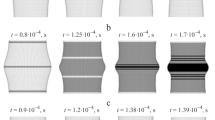Abstract
We present a procedure of experimental and theoretical prediction of fatigue strength characteristics for cylindrical shells with an annular concentrator under distributed axial cyclic loads. The results of fatigue testing of segments of the shells prepared by partitioning the shells along their generating lines are used as initial data for the prediction of the fatigue characteristics of the shells. The procedure involves statistical prediction. It is based on an approach within the theory of reliability whereby the probability of failure of a system is calculated from the data on the probabilities of failure of the system components. Based on the calculation results, we plot the curves of distribution of the fatigue lives of the shells versus cyclic load.
Similar content being viewed by others
Abbreviations
- M t :
-
longitudinal bending moment per unit length
- T x :
-
axial load per unit length
- K b :
-
bending ratio
- l :
-
variable distance between the section of clamps of the testing machine and the concentrator
- l 1 :
-
half-length of the middle part of a model specimen (i.e., half-length of sampling)
- h 1 andh 2 :
-
smaller and larger thicknesses of the model specimen or of the shell wall
- n :
-
h 2/h 1 thickness ratio of the model specimen or of the shell wall
- ∏ m :
-
compliance of the testing machine with respect to the angle of its clamps
- D 2 :
-
cylindrical stiffness of the specimen at a site of lengthl 2 and thicknessh 2
- P m z (t) :
-
probability of the event of failure of not more thanm elements (amongz elements of the system) by the timet
- P 0(t):
-
probability of no-failure of an element by the timet
- C k z :
-
number of combinations ofz elements, each combination consisting ofk elements
- N sh R :
-
number of cycles to fracture of the shell
- N s R :
-
number of cycles to fracture of a segment of the shell
- N sh R :
-
measured fatigue life of the shell
- P sh(N sh R ):
-
probability of fracture of the shell after the number of load cycles less than or equal toN sh R
- f :
-
distribution function of the fatigue life of the shell
- f −1 :
-
function which is the inverse of the distribution function of the fatigue life of the shellf
- \(\underline {\Phi (u)} \) :
-
normalized Laplace function
- \(\underline {\log N_R^s } \) :
-
average of the logarithms of the number of cycles to fracture of the shell segments
- logN sh R :
-
average of the logarithms of the number of cycles to fracture of the shells
- SlogN s R :
-
estimate of the RMS deviation of logarithms of fatigue lives of the segments
References
M. N. Regulskii, “On fatigue testing of structural elements of asymmetrical profile under axial loading,”Probl. Prochn., No. 5-6, 62–68 (1995).
V. V. Bolotin,Life of Machinery and Structures [in Russian], Mashinostroenie, Moscow (1990).
I. A. Birger, “Deterministic and statistical models of durability”, in:Problems of Reliability of Aircraft [in Russian], Mashinostroenie, Moscow (1963), pp. 105–150.
Additional information
S. P. Timoshenko Insitute of Mechanics, National Academy of Sciences of Ukraine, Kiev, Ukraine. Translated from Problemy Prochnosti, No. 6, pp. 23–31, November–December, 1998.
Rights and permissions
About this article
Cite this article
Regulskii, M.N. Prediction of fatigue strength characterics for cylindrical shells with an annular concentrator. Strength Mater 30, 575–581 (1998). https://doi.org/10.1007/BF02523161
Received:
Issue Date:
DOI: https://doi.org/10.1007/BF02523161



